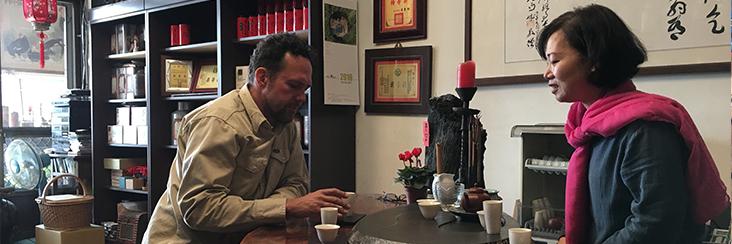
What's Special About Eco-Cha Tea Club Batch #3?
In our previous post, we gave a brief description of Batch #3, along with its source, and how this tea is a perfect match in terms of what Eco-Cha aspires to promote in our involvement with the local specialty tea industry here in Taiwan. So now we just want to talk about the tea itself, and how we determine this batch to be a unique find, and why it qualifies as our next choice for the Eco-Cha Tea Club.

Above is a shot of Andy visiting his tea friend of 20 years — Ms. Guo, as they sit and brew a pot of this month's tea — a batch of organically cultivated Jin Xuan Oolong that has been medium roasted by her husband, Mr Lee. Mr. Lee procured this batch of tea from a friend's winter 2015 harvest because he specializes in "bug-bitten tea". This is a category of tea that goes beyond the standard specialty classifications of cultivar, terrior, heirloom strain, and traditional processing methods. It is in a class of its own because it is the result of a natural effect of a particular insect that feeds on the sap of the tea leaves during their early growth phase. This "bug-bitten effect" is completely unpredictable due to the fact that it is not possible to control the extent of the Green Leaf Hopper's effect on the organically grown tea leaves. Consequently, this batch-specific condition of the harvested leaves requires risk-taking, intuitive skills in processing that are on a completely different level of tea making than any standard production of tea. This is why we hold this type of tea in highest esteem. It is by definition a batch-specific, local specialty that involves innovative methods of production to make a tea that no one else can replicate.
This type of tea originally became famous under the name Oriental Beauty, which is a regional specific tea produced in northern Taiwan. In the last 15 years or so, tea producers all over Taiwan have been cautiously exploring the natural production of tea that involves the participation of the Green Leaf Hopper. We are dedicated fans of this exploration. We can only believe that this was the way tea was produced before modern agriculture was introduced, involving pest control with the objective of maximum yield and consistency. While this is a valid agricultural goal that allows for responsible production, it is also the antithesis of traditionally made, pre-modern tea production. We have a pointed interest in supporting specialty tea production that involves natural cultivation and skilled processing methods. This is the crux of artisan tea. We found a batch of tea from the most recent harvest of winter that represents this, and are excited to share it with our club members who have made a commitment to having a share in our exploration of teas that are not found elsewhere.

Beyond the natural cultivation methods employed by local, family-run farms who have generations of experience in traditional tea making, we are also interested in the specialized production of Jin Xuan tea. This is a hybrid strain of Qing Xin Oolong cross-bred with the naturally occurring wild tea tree in Taiwan that possesses inherent immune system genetic traits that allow it to thrive in the local environment. Only in recent years has this strain been made as a traditional Oolong rather than the minimally oxidized, unroasted production methods that this tea type is commonly produced. In our experience, Jin Xuan excels in these production methods. When Jin Xuan tea leaves are sufficiently oxidized and roasted to the appropriate degree, as traditionally made tea is — according to seasonal conditions, it offers a fine quality, substantial brew that stands apart from the "green Oolong" that has been popularized by large scale tea production. We are excited to introduce Jin Xuan Oolong as a traditionally made tea rather than a minimally processed tea in order to let you know what is involved in the making of an artisan tea.


